#Polemonium reptans
Explore tagged Tumblr posts
Text



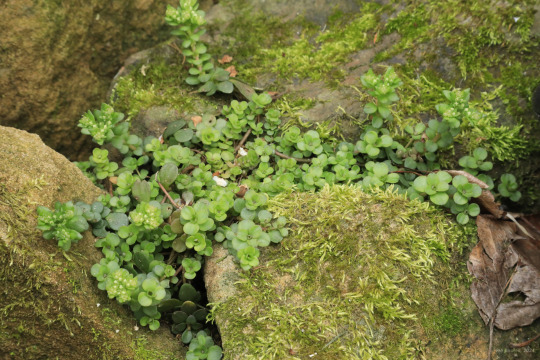








Update on the native wildflower shade garden . . .
Since my last post about the sharp-lobed hepatica several weeks ago, the wildflowers in the shade garden have made a significant push. All of the live plants I put in the ground last fall have made it through the winter, and many of the seeds I planted have germinated and sprouted. Quick survey:
Top: the spreading Jacob's ladder (Polemonium reptans) is mounding beautifully and positively dripping with violet-blue, bell-shaped flowers. The plant lures many pollinators, including bees, flies, butterflies, moths, and beetles. And that foliage is so lush and green . . .
Next one: woodland stonecrop (Sedum ternatum) has established itself in the nooks and crannies of one of my rock features and is getting ready to bloom.
Next two: although the sharp-lobed hepatica (Hepatica acutiloba) has nearly finished blooming, the real joy starts for me when the leathery, thrice-lobed leaves with their often deeply-variegated patterns begin to unfold. This is flat-out one of the most unique and gorgeous wildflowers of North America.
Next one: creeping woodland phlox (Phlox stolonifera) makes for an enchanting ground cover and will spread quite rapidly in the right conditions. I have strong feelings for all the native phlox species, but this one has stolen my heart. It's native to a narrow strip of the Appalachian Mountains from Georgia to Pennsylvania. In the spring around here, it absolutely lights up streambanks with its dainty pink to rose-colored flowers.
Next one: dwarf-crested iris (Iris cristata) is another lovely groundcover but beware - it spreads like wildfire. The lavender and yellow to orange-crested flowers are a treasure to behold from late April to early May. And its arrow-like foliage provides much-needed contrast in the garden.
Next: among the seeds I planted, the yellow pimpernel (Taenidia integerrima) is making the strongest push. The plant produces yellow-flowered umbels similar to golden Alexanders and is a high-value nectar source for many pollinators. It's also the host plant for the black swallowtail and Ozark swallowtail butterflies.
Next two: anyone who visits this Tumblr regularly needs no introduction to heartleaf foamflower (Tiarella cordifolia), my unofficial poster child for Appalachian spring. I simply would not have a native wildflower garden without it. One of my foamflowers is a hybrid (sugar and spice) cultivated for its deeply dissected leaves and intense variegation.
Last (but not least): my eastern red columbine (Aquilegia canadensis) pretty much takes cares of itself - it's one of the best starter wildflowers for beginner gardeners, hardy and undemanding. But man, does it produce loads of beautiful red and yellow, bell-shaped flowers.
#appalachia#west virginia#vandalia#flora#spring#native wildflowers#shade garden#native wildflower garden#spreading jacob's ladder#woodland stonecrop#sharp-lobed hepatica#creeping woodland phlox#dwarf-crested iris#yellow pimpernel#heartleaf foamflower#eastern red columbine
42 notes
·
View notes
Text

Polemonium reptans ❀*ੈ‧₊˚
#enchanted woodland#my photography#my photo#wild flowers#spring flowers#flower photography#floral#florist#fairy#fairy tales#fairy coquette#magic#forest#nature#witchy#woodland#purple flowers
22 notes
·
View notes
Text
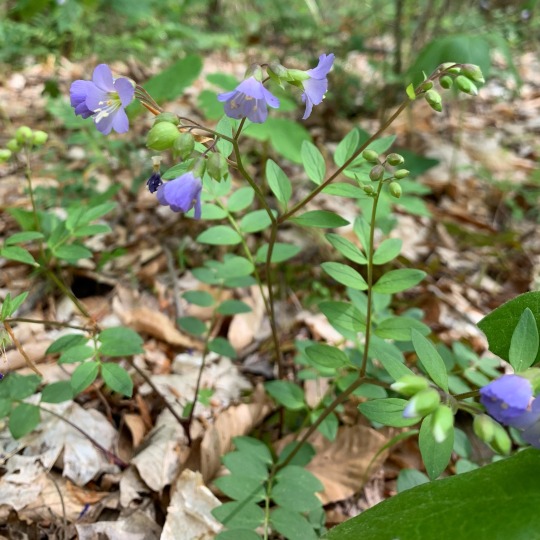
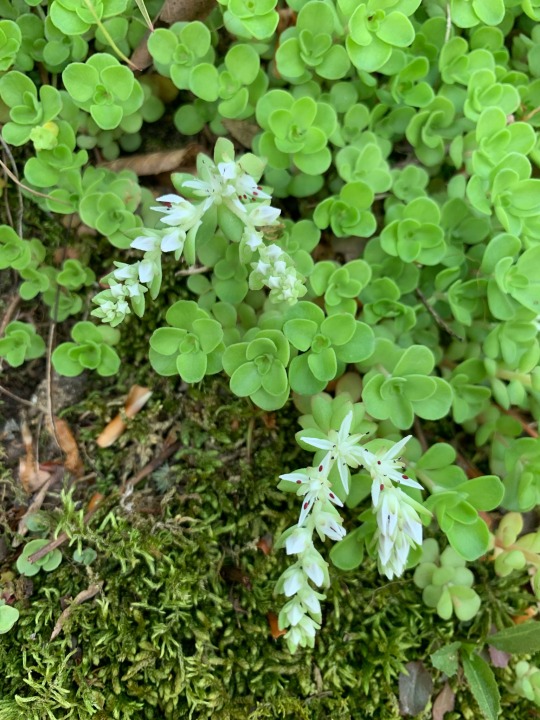
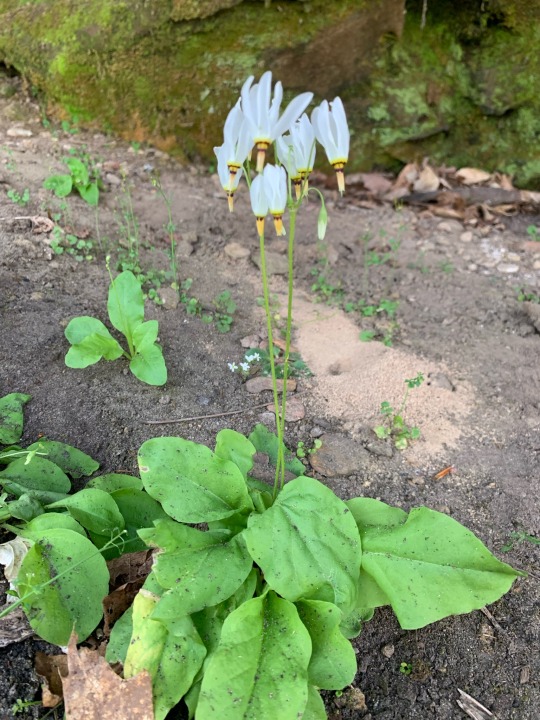

Polemonium reptans (jacob’s ladder) / Sedum ternatum (woodland stonecrop) / Primula frenchii (french’s shooting star) Conopholis americana (american cancer-root)
#flower#nature#wildflowers#naturecore#dirtcore#botany#native flowers#native plants#parasitic plants#forestcore
14 notes
·
View notes
Text
Jacob's Ladder (Polemonium reptans L. var. reptans)
Polemoniaceae (Phlox Family) Synonym(s): Greek Valerian, Jacob’s Ladder Base Flower Color: BlueReproductive Phenology: Apr, May, Jun For more information about this plant, Click Here.

View On WordPress
0 notes
Photo


Polemonium reptans
spreading jacobs ladder
10 notes
·
View notes
Text
19 through 23 November 2018
This was a three-day work week for me and two Thanksgiving dinners! Monday I returned from Italy. Tuesday Wednesday morning we were treated to a herbarium workshop. Last April we collected and pressed some plant material from the garden. I chose Polemonium reptans L. accession 2015-0288/3 located in the North American woodland. Jill ensured they all dried properly. We had the opportunity to mount our specimen. It was a great morning.

Wednesday afternoon I spent with Susyn working on taxonomic questions. Thursday morning Franzsika and I went to collect some variegated ivy that was used for the Christmas Fayre over the weekend. That afternoon I had time to work on the records. In the evening, I was treated to a Thanksgiving dinner, on the actual day, with friends. My first Thanksgiving that was’t my own in two decades. It was a very nice treat.
Friday I ran errands, including meeting Jody and Steve in the morning. I spent the afternoon with Elizabeth preparing for our Thanksgiving the following evening. Then I met with Jody and Steve and we watched Aladdin in the West End. Thanksgiving was a blast and we didn’t get home until 3am. We spent Sunday recovering.
Medicinal plant of the week is Ziziphus jujuba. Allison brought some fruit to the meeting and it was small and delicious.
New plant ident:
Amaranthaceae Amaranthus hybridus
Amaryllidaceae Nerine bowdenii ‘Vesta K’
Apiaceae Eryngium bourgatii ‘Picos Blue’
Asteraceae Argyranthemum pinnatifidum subsp. pinnatifidum
Asteraceae Chrysanthemum nankingense
Begoniaceae Begonia soli-mutata
Crassulaceae Kalanchoe delagoensis
Ginkgoaceae Ginkgo biloba
Salicaceae Salix alba
Thymelaeaceae Daphne bholua ‘Jacqueline Postill’
Plant of the week
Cucurbitaceae Luffa aegyptiaca Mill. or Luffa cylindrica (L.) M.Roem.

common name(s) - sponge gourd, Egyptian cucumber, Vietnamese luffa, dishrag gourd, rag gourd, sponge gourd, vegetable-sponge, smooth luffa; Arabic اللوف; French courge torchon; Portuguese bucha synonym(s) - Bryonia cheirophylla Wall.; Cucumis pentandrus Roxb. ex Wight & Arn. [Invalid]; Luffa acutangula var. subangulata (Miq.) Cogn.; L. aegyptiaca var. leiocarpa (Naudin) Heiser & E.E. Schill.; L. aegyptiaca var. peramara F.M.Bailey; L. cylindrica var. insularum (A.Gray) Cogn.; L. cylindrica var. leiocarpa Naudin; L. cylindrica var. minima Naudin; L. insularum A.Gray; L. leucosperma M.Roem.; L. pentandra Roxb.; L. petola Ser.; L. subangulata Miq.; L. sylvestris Miq.; Melothria touchanensis H. Lév.; Momordica carinata Vell.; M. cylindrica L.; M. luffa L.; M. reticulata Salisb.; Poppya fabiana K.Koch; Turia cordata Forssk. ex J.F Gmel.; T. cylindrica Forssk. ex J.F Gmel.; T. sativa Forssk. [Invalid] conservation rating - none native to - Southeast Asia location - tropical corridor, accession 2018-0254 leaves - five angled stems with tendrils on the axils of leaves to facilitate climbing, leaves are broadly ovate to reniform, dark green with silvery patches on the topside, five to seven deep lobes, dentate, scabrous, apex acute, base cordate, petiole hispid and 50mm to 100mm long flowers - monoecious, produced on leaf axils, and consist of five petals of a conspicuous yellow colour, 50mm to 100mm across, united below in a bell-shaped corolla; fruit, grouped as pepo, approximately 300mm long, resembles a cucumber in shape and size; fruits take three to four months to ripen habit - annual climber habitat - tropical and subtropical climates, requires warm summer temperatures and a long, frost-free growing season pests - cucumber beetles, aphids (e.g. Aphis gossypii) disease - downy mildew, powdery mildew, alternaria blight, angular leaf spot hardiness - >15ºC (H1a) soil - moisture of at least 10% to 15% above the permanent wilting point is required to maintain growth; well-drained sandy loams are preferred; is sensitive to acid soils; the optimal soil pH is 6.0 to 6.8 sun - full sun, average temperature should be around 30°C to 35°C propagation - seed cultivation - best grown with a trellis support; requires lots of heat and lots of water to thrive nomenclature - Cucurbitaceae - cucurbita - the Latin name for the bottle-gourd, Lagenaria siceraria; Luffa - loofah, from the Arabic name, louff, for Luffa cylindrica; cylindrica - long and round, cylindrical NB - The young fruit is eaten as a vegetable and is commonly grown for that purpose in tropical Asia. Unlike the young fruit, the fully ripened fruit is strongly fibrous and inedible, and is used to make scrubbing bath sponges. An edible oil can be extracted from the seeds. The resulting oil meal can be fed to rabbits and catfish, or used as a fertilizer.
References:
CABI [online] https://www.cabi.org/isc/datasheet/31693 [27 Nov 18]
Gledhill, David, (2008) The Names of Plants, fourth edition; Cambridge University Press; ISBN: 978-0-52168-553-5
IUCN [online] http://www.iucnredlist.org/search [27 Nov 18]
Ontario Ministry of Agriculture, Food and Rural Affairs [online] http://www.omafra.gov.on.ca/CropOp/en/spec_veg/cucurbits/luffa.html [27 Nov 18]
Plant List, The [online] http://www.theplantlist.org/tpl1.1/record/kew-2338909 [27 Nov 18]
Wikipedia [online] https://en.wikipedia.org/wiki/Luffa_aegyptiaca [27 Nov 18]
2 notes
·
View notes
Photo

Jacob's Ladder, Polemonium reptans (by me)
#Jacob's Ladder#Polemonium reptans#Polemonium#Polemonioideae#Polemoniaceae#Ericales#flowers#plants#spring#Highland Park#Middlesex County#New Jersey#mine
16 notes
·
View notes
Photo



What we don't know...about Andrena polemonii. See this specimen? This came from the wonderful native plant center in northern Delaware called Mount Cuba. Matt Sarver found it doing surveys of bees and targetted the plants that had specialist bees known to associate with them. One of those plants is Polemonium reptans which is the host to the bee pictured. So no big deal that Matt found a bunch of the bees except for the fact that the nearest known record for that species was on the border of Ohio and WV. Does that mean they flew in from WV to visit Mt. Cuba? Almost certainly not, more likely than not there are pockets of A. polemonii between these two sites...just no one has looked. Photo by Anders Croft. Yup, they are blueish
55 notes
·
View notes
Photo

The Jacob’s Ladder (Polemonium reptans) offers a good supply of pollen to a wide variety of bees in search of a reliable food source. The common name for this perennial woodland wildflower was derived from the configuration of the compound leaves with opposite leaflets, which resemble the steps of a ladder as recalled in Jacob’s dream from the bible.
69 notes
·
View notes
Photo


Jacob’s Ladder (Polemonium reptans)
145 notes
·
View notes
Photo

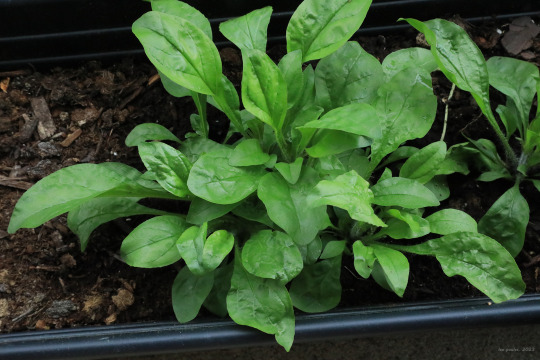



This past January, I made a resolution to get my garden beds to 70 - 75% native plants. My, oh my, that was an ambitious goal. I probably need another year or two to reach that level of coverage. On the other hand, the native wildflower seeds I purchased in January have germinated and produced healthy, vigorous shoots (above). Today, I planted the spreading Jacob’s ladder (Polemonium reptans) in four different beds. I have spots prepared for the rest also, including hairy beardtongue (Penstemon hirsutus), blue-stemmed goldenrod (Solidago caesia), yellow pimpernel (Taenidia integerrima), and wild geranium (Geranium maculatum). The project is at least moving ahead; this coming September, I’ll buy or collect more seeds to plant before the first frost.
#appalachia#vandalia#native plants#native plant gardening#native wildflower garden#pollinator garden#spreading jacob's ladder#hairy beardtongue#blue-stemmed goldenrod#yellow pimpernel#wild geranium#love your native plants
34 notes
·
View notes
Photo

0 notes
Photo

One of my favorites. Several years ago I did some seeding of various species and after a few years this popped since. Since then it has re-seeded a number of plants around it. Polemonium reptans (Jacob's Ladder)
220 notes
·
View notes
Text
Okay here we go: of course the easy one is the glory-of-the-snow, called by some scilla and Latin name Chionodoxa. But the cool ones are: a brown-leafed version of our native geranium, Geranium maculatum; a gold-leafed cultivar of Filipendula ulmaria, aka meadowsweet; the cool one no one got: spreading Jacob’s ladder, Polemonium reptans. Those will get pretty blue flowers pretty soon. The weeds: mock strawberry, Potentilla indica; ground ivy, Latin name Glechoma hederacea; and a little tiny bit of peppermint which once you have it you never quite get rid of. There’s also a fallen catkin from a small willow, Salix discolor. Mixing different colors of foliage is my garden jam so I love seeing these friends springing to life. [Oops. Edit: I missed a couple violet leaves off to the right.]
Because of a deadly new tick disease that has arrived in Pennsylvania I won’t be roving off trails into the woods this year after wildflowers so you may see more garden pictures this year. But I should be getting out to the countryside for lake and landscape pictures tomorrow. Maybe some newly returned birds too. I’ll stay on the trails but I still have high hopes!

Way back when hardly anyone followed this blog and the ones who did were mostly into plants and plant identification, I used to post a picture once in a while and see how many plants people could identify. Who wants to try with this one from the garden? (Extra points for the weeds)
258 notes
·
View notes
Photo





Drier hillside, Richardson preserve, section of depositional karst conglomerate based hillside. Open woodland sections with dry soils surrounded by mesic zones often have their own unique forbe community compared to the rest of the forest. In this photoset the light glazes over many different members that make up this mixing composition. twords the base of the hill we see normal mesic riparian floodplain and flat species such as Phlox divaricata, Thalictrum thalictroides, Geranium maculatum, Polemonium reptans, Polemonium reptans. A species more prominent in mesic areas yet mixed into all sections of the forest floor mosaic is Delphinium tricorne, Collinsia verna ( an annual) too. The drier sections show signs of mainly Packera obovata, though what’s also apparent in the drier sections is what’s to come, Camassia scilloides and Allium cernuum.
Adaptation to water requirements and being more associated to a niche based on soil chemistry can be a fairly obvious thing once you see your plant communities change, species do prefer an active site and will “compete” or rather fill in the niche better, have higher fetality(reproductive success of seed made), recruitment ( new individuals that actively are found and may establish) and Natality( a true function of recruitment, a rate at which the species propagates(new recruits/total population in area)), if site requirements favor the species over another that is coevolved in the same region. Looking at these mosaics also gives you a spatial reference for the size of the habitat/deposit/site of interest and may even tell you the potential for other species that are of more interest that could be hidden. Zones where more establishment long term meet a zone or area with high average mortality or low average species specific density form a theoretical fluctuating border to the realized niche, while the theoretical boarder may be in flux due to active recruitment, the yearly average or areas with commonly low density can be considered a indiscrete abrupt area that boarders a potential edge or theoretical/fundamental niche edge. Competition favoring a new/ different species over a species that was already there can also eventually disrupt this border so these things are considered somewhat transient or always having potential fluctuations ecologically speaking.

Atlantic Woodland Cammas, Camassia scilloides
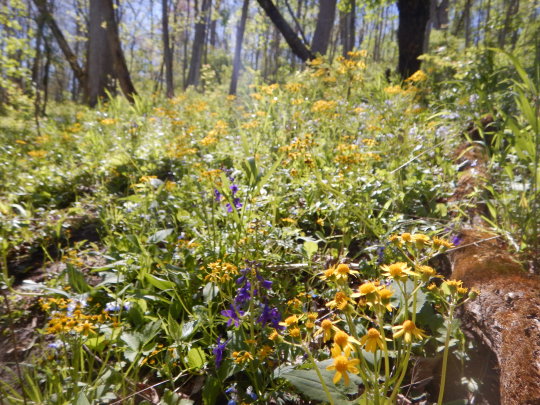
Packera obovata, Golden Roundleaf Groundsel and Delphinium tricorne, Dwarf Larkspur
#Ohio#wildflowers#plantblr#botany#kawaii#plants#meadowcore#cottagecore#Forest#forestcore#camassia#camassia scilloides#packera#packera obovata#delphinium tricorne#Delphinium
13 notes
·
View notes
Text
1 through 4 January 2019
For New Year’s Eve, I had Susie (who captured the evening beautifully with this shot) and Richard over for a quiet evening of cocktails, Champaign, risotto and a bit of fireworks on the telly. Happy New Year everyone.

I worked New Year’s Day and recorded all plants with at least one open flower. We have had an unseasonably warm autumn and start to winter; the result was 159 plants in flower:
Abutilon × milleri
Acanthus sennii
Ageratina ligustrina
Agrostemma githago
Alstroemeria aurea
Alstroemeria psittacina
Alyssum montanum 'Berggold'
Amicia zygomeris
Anisodontea capensis
Arabis procurrens
Arbutus canariensis
Arbutus unedo f. rubra
Argyranthemum pinnatifidum subsp. pinnatifidum
Bergenia × schmidtii
Bergenia crassifolia
Bidens aurea
Buddleja officinalis
Calendula officinalis
Camellia sinensis
Cestrum parqui
Cestrum psittacinum
Chimonanthus praecox
Chimonanthus praecox Grandiflorus Group
Chrysanthemum 'Kakinomoto'
Cistus creticus
Clematis cirrhosa 'Wisley Cream'
Cobaea scandens
Colletia hystrix 'Rosea'
Colletia paradoxa
Coronilla valentina subsp. glauca 'Citrina'
Correa backhousiana
Cyclamen coum
Dahlia imperialis
Daphne bholua 'Jacqueline Postill'
Dasylirion acrotrichum
Descurainia millefolia
Dianthus deltoides
Dianthus gratianopolitanus
Dichroa febrifuga
Drimys winteri
Echium italicum subsp. bieberstenii
Eomecon chionantha
Eranthis hyemalis
Eriobotrya japonica
Eruca vesicaria subsp. sativa
Erysimum 'Bowles Mauve'
Eschscholzia lobbii
Fragaria 'Pink Panda'
Fuchsia 'Hawkshead'
Fuchsia microphylla
Gaillardia aristata
Galanthus 'Armine'
Galanthus 'Art Nouveau'
Galanthus caucasicus
Galanthus cilicicus
Galanthus elwesii
Galanthus elwesii 'Grumpy'
Galanthus elwesii 'Lode Star'
Galanthus elwesii 'Mrs Macnamara'
Galanthus elwesii 'Snowfox'
Galanthus elwesii var. elwesii 'Kite'
Galanthus elwesii var. monostictus Hiemalis Group
Galanthus 'James Backhouse'
Galanthus 'John Gray'
Galanthus 'Lapwing'
Galanthus 'Lavinia'
Galanthus 'Lyn'
Galanthus nivalis
Galanthus nivalis 'Melvillei'
Galanthus plicatus 'Florence Baker'
Galanthus plicatus 'Warham'
Galanthus reginae-olgae 'Blanc de Chine'
Galanthus 'Rose Lloyd'
Geranium macrorrhizum
Geum rivale
Halimium lasianthum 'Sandling'
Hebe salicifolia
Hebe stricta
Helichrysum bracteatum
Helleborus × hybridus
Helleborus × hybridus 'Early Purple'
Helleborus × sternii
Helleborus argutifolius
Helleborus cyclophyllus
Helleborus foetidus
Helleborus foetidus 'Wester Flisk'
Helleborus niger
Hoheria sexstylosa
Hyacinthoides aristidis
Hyacinthoides mauritanica
Hydrangea macrophylla 'Sir Joseph Banks'
Iberis amara
Iberis sempervirens
Iris unguicularis
Iris unguicularis 'Walter Butt'
Jasminum mesnyi
Jasminum nudiflorum
Justicia floribunda
Laurus nobilis
Lavandula dentata var. dentata (Grey Leaved Form)
Lavandula minutolii var. minutolii
Leonurus sibiricus
Leucojum aestivum subsp. aestivum
Lithodora zahnii
Loasa triphylla var. vulcanica
Lobelia erinus
Lonicera elisae
Lonicera standishii
Mahonia japonica
Mahonia napaulensis
Medicago arborea
Narcissus bulbocodium subsp. bulbocodium var. conspicuus
Narcissus dubius
Narcissus romieuxii 'Julia Jane'
Nerine bowdenii 'Mark Fenwick'
Nicotiana rustica
Nicotiana tabacum
Nigella sativa
Petasites fragrans
Polemonium reptans
Polyspora indet.
Primula × pruhonicensis
Primula vulgaris
Prunus × subhirtella 'Autumnalis Rosea'
Prunus mume
Ricinus communis 'Carmencita'
Rosa × odorata 'Bengal Crimson'
Rosa 'Ausmas' [GRAHAM THOMAS]
Rosa chinensis 'Veridiflora'
Rosmarinus officinalis
Rosmarinus officinalis 'Prostratus'
Ruta graveolens
Salvia 'Amistad'
Salvia atrocyanea
Salvia elegans 'Honey Melon'
Salvia guaranitica ‘Black and Bloom’
Salvia guaranitica 'Black and Blue'
Salvia haenkei 'Prawn Chorus'
Salvia involucrata
Salvia involucrata 'Bethellii'
Salvia keerlii
Salvia longistyla
Salvia 'Phyllis' Fancy'
Salvia stachydifolia
Sarcococca confusa
Sarcococca hookeriana var. digyna
Sarcococca hookeriana var. hookeriana
Sarcococca hookeriana var. hookeriana 'Ghorepani'
Sarcococca ruscifolia var. ruscifolia
Scabiosa minoana subsp. minoana
Scrophularia lucida
Senna corymbosa
Stylophorum lasiocarpum
Tagetes lemmonii
Viburnum tinus 'Eve Price'
Vinca difformis
Vinca major
Viola odorata 'Czar'
Westringia fruticosa
I finished reviewing all 20,621 accessions and separating our seeds from our plants. I had no idea it would take a week to do this. I’m happy I did it this way; I am more familiar with the data and aware of so many different ways the database has been used over the years.
We made a huge dent in the pile that needed to be shredded and the compost pile has been moved along so we have an empty bay to start filling.
We are working shorter hours now, down to an average of 35 hours per week, in line with the rest of the staff. It is so civilised and European. Because we work 39 hours per week in the summer, we now finish at 15.30 Monday through Thursday and 13.00 on Friday. I’m very happy with these longer weekend. I will be able to take a much earlier train to the continent for weekend jaunts.
Plant of the week
Lamiaceae Rotheca myricoides (Hochst.) Steane & Mabb.

common name(s) - butterfly bush, blue glory bower, blue butterfly bush, butterfly clerodendrum, blue glory bower, blue glorybower, blue cat's whiskers synonym(s) - Clerodendrum dekindtii Gürke; C. d. var. dinteri Thomas; C. myricoides (Hochst.) R.Br. ex Vatke; C. m. var. camporum Gürke; C. m. var. chartaceum Moldenke; C. m. var. grossiserratum Gürke; C. m. var. involutum B.Thomas; C. m. f. lanceolatilobatum R.Fern.; C. m. var. laxum Gürke; C. m. var. microphyllum Gürke; C. m. var. savanorum (De Wild.) B.Thomas; C. neumayeri Vatke; C. savanorum De Wild.; C. schlechteri Gürke; C. sylvaticum (Hochst.) Briq.; C. ugandense Prain; Cyclonema myricoides Hochst.; C. sylvaticum Hochst.; Cyrtostemma myricoides (Hochst.) Kunze; Rotheca myricoides f. lanceolatilobata (R.Fern.) R.Fern.; R. m. subsp. myricoides; Siphonanthus myricoides (Hochst.) Hiern; Spironema myricoides Hochst. conservation rating - none native to - Kenya, Uganda location - glasshouse four, accession _____ leaves - glabrous, elliptic to narrow-obovate, glossy bright green, serrate margins, wedge-shaped bases flowers - showy, five-petaled flowers bloom June to September, showy, curved, outward-arching, purple stamens (resembling butterfly antennae); black, fleshy fruit follows habit - suckering evergreen shrub with a somewhat open habit to 2m tall and 2m wide habitat - in thickets in rocky places, along streams and at the edges of evergreen forest, to 1,700m pests - aphids, whitefly, mealybugs, scale, spider mites disease - leaf spot hardiness - to 1ºC (H2) soil - organically rich, evenly moist, well-drained sun - full sun to part shade propagation - seed, cuttings pruning - prune stems hard to the ground in early spring if compact plant form is desired nomenclature - Lamiaceae - the mint or deadnettle family, gullet, the name in Pliny refers to the gaping mouth of the corolla; Rotheca - Latinisation of the Malayalam ചെറിയ തേക്ക് words cheriga meaning small and thekku meaning teak; myricoides - from the French myriades meaning ten thousand and a Latinization of the Greek –oides meaning to see; resembling Myrica
References, bibliography:
Flora of Zimbabwe [online] https://www.zimbabweflora.co.zw/speciesdata/species.php?species_id=149090 [31 Dec 18]
Gledhill, David, (2008) The Names of Plants, fourth edition; Cambridge University Press; ISBN: 978-0-52168-553-5
IUCN [online] http://www.iucnredlist.org/search [31 Dec 18]
Missouri Botanical Garden [online] http://www.missouribotanicalgarden.org/PlantFinder/PlantFinderDetails.aspx?kempercode=a496 [31 Dec 18]
Plant List, The [online] http://www.theplantlist.org/tpl1.1/record/kew-179968 [31 Dec 18]
0 notes